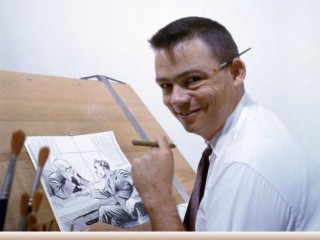
Bill Mauldin biography
Date of birth : 1921-10-29
Date of death : 2003-01-22
Birthplace : Mountain Park, New Mexico
Nationality : American
Category : Famous Figures
Last modified : 2011-01-21
Credited as : Editorial cartoonist, and biographer, received 2 Pulitzer prizes and syndication
The incomparable cartoon biographer of the ordinary GI in World War II, Bill Mauldin earned two Pulitzer prizes and syndication in over 250 newspapers for his mordant drawings.
The son of Sidney Albert and Edith Katrina (Bemis),Bill Mauldin was born on October 29, 1921, in Mountain Park, New Mexico. He attended public schools in New Mexico and Arizona, depending upon where his father happened to be unemployed. A scrawny boy, often confined to bed by rickets, he expressed his daydreams in drawings of himself as a cowboy or other heroic figure. While in high school, Mauldin took a correspondence course in cartooning. In 1939 he studied cartooning at the Chicago Academy of Fine Arts. Mauldin then worked in Phoenix, drawing gag cartoons for Arizona Highways.
In September 1940 he enlisted in the Arizona National Guard, which five days later was federalized. A member of the U.S. Army's 45th Division, Mauldin went overseas in 1943 to Sicily, where he joined the Mediterranean edition of Stars and Stripes, the Army's wartime newspaper. Mauldin covered the fighting in Sicily, Salerno, Monte Cassino, and Anzio and then in France and Germany. He was wounded at Salerno and received the Purple Heart.
Mauldin's cartoons for Stars and Stripes pictured the ordinary, unheroic GIs, wearily slogging on, getting a job done, and wanting to go home. Like Ernie Pyle's prose, they vividly portrayed what GI life was really like and intimately expressed the Gl's hopes and dreams, fears and hardships. For many Americans, Mauldin's combat-weary team of Willie and Joe became the archetypical GIs of the war in Europe. Disenchanted yet dignified, dirty and bearded, the battle-hardened Willie and Joe were more interested in dry socks than in the lofty rhetoric of war aims, and they hated officers almost as much as they hated the war.
While most of the Army hierarchy approved of Mauldin's cartoons as a healthy outlet for the average conscript's emotions, some officers—particularly Gen. George S. Patton—objected to the grimy, realistic public image Willie and Joe were projecting of the U.S. Army. Nevertheless, Mauldin's melancholy pen-and-ink commentaries on Gl life were brought together in several published collections, including Star Spangled Banter (1941 and 1944), Mud, Mules and Mountains (1944), and Up Front (1945), which earned Mauldin a 1945 Pulitzer Prize.
Released from the army in June 1945, Mauldin went to work for United Features Syndicate, which distributed his cartoon strips to more than 180 newspapers in the United States under the evolving titles "Sweating It Out," "Back Home," and "Willie and Joe." Although his first postwar collection, Back Home, won critical acclaim, the angry, bitter tone of Mauldin's liberal cartoons soon led him to be dropped by one newspaper after another.
In 1950 he went to Hollywood to try his hand as an actor and technical advisor in several films, and early in 1952 he went to the war front in Korea. His report of the experience was published as Bill Mauldin in Korea (1952). In 1956 he ran as a Democrat for Congress in New York's heavily Republican 28th Congressional District and was easily trounced by the incumbent, Katherine St. George.
Mauldin joined the staff of the St. Louis Post-Dispatch as editorial cartoonist in 1958 and won another Pulitzer Prize for his cartoons the next year. His wry satires on the politics of Eisenhower's last years in the presidency were collected in What's Got Your Back Up? (1961). I've Decided I Want My Seat Back (1965) summed up his liberal commentaries on the desegregation struggles of the early 1960s. In June 1962 Mauldin moved to the Chicago Sun-Times, where his editorial cartoons were syndicated to more than 200 newspapers. Continuing "to buck power," as he put it, to satirize the high and mighty, Mauldin earned the reputation as a worthy successor to Herblock, the editorial cartoonist for the Washington Post. His books included The Brass Ring (1971) and Mud and Guts (1978). An avid flying buff, Mauldin described his air experiences in articles for Sports Illustrated. His honors included the 1962 Cartoonist of the Year award of the National Cartoonists Society and the Sigma Delta Chi journalism fraternity's 1963, 1969, and 1972 awards for editorial cartooning.
Mauldin's work was part of an exhibit at the National Archives in Washington, D.C. in 1992. The exhibit, called "Draw! Political Cartoons From Left to Right," featured Mauldin and five other prominent political cartoonists. A fiftieth-anniversary edition of his classic Up Front was published in 1995.
Bill Mauldin's best known books are Up Front (1945); Back Home (1947); What's Got Your Back Up? (1961); and I've Decided I Want My Seat Back (1965); His wartime cartoons are analyzed in John Morton Blum, V Was For Victory, Politics and American Culture During World War II (1976); Biographical data appears in Who's Who in America (1964-1965). Also see American History Illustrated (March/April 1992); and The Atlantic Monthly (June 1995).
















